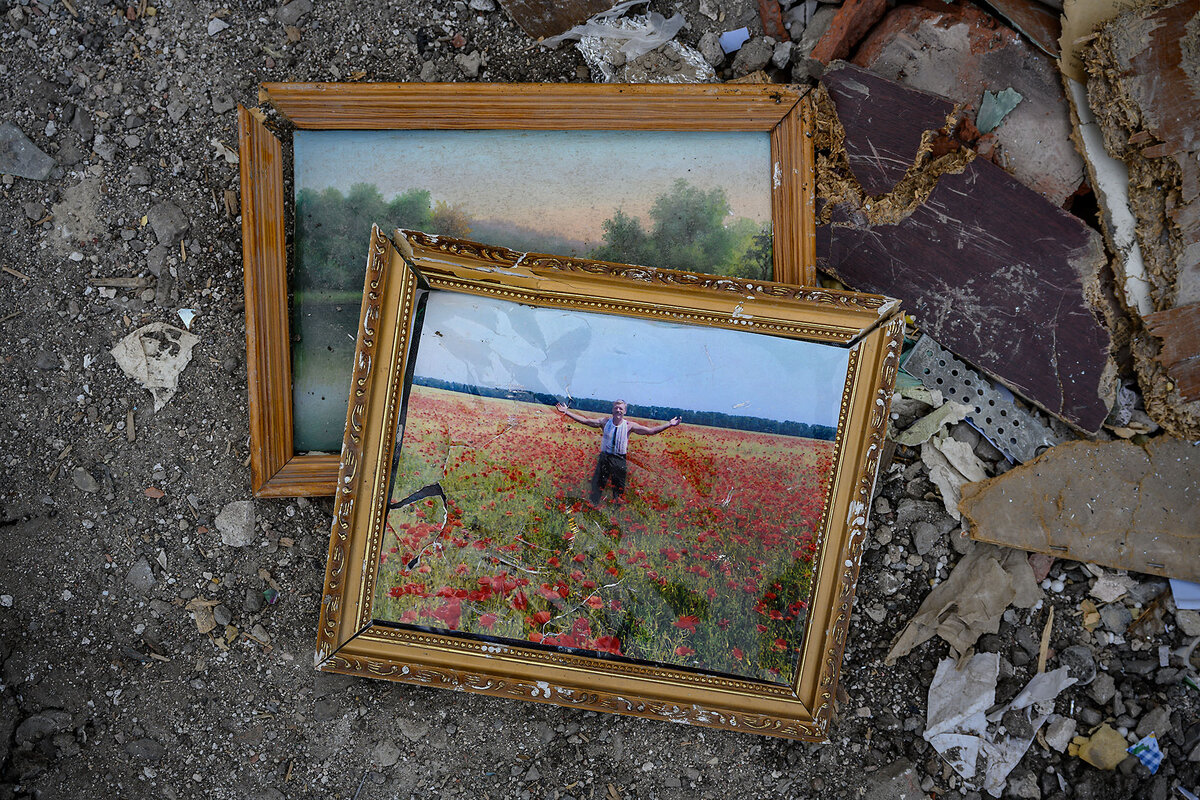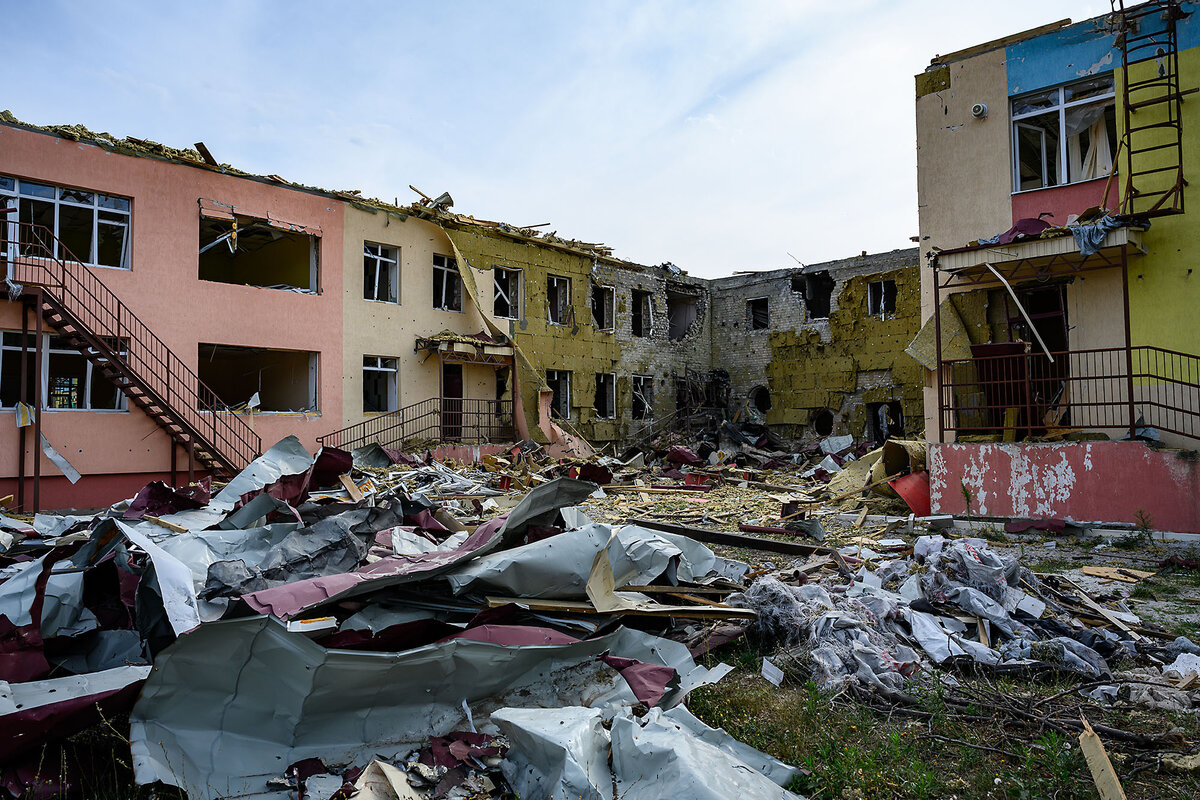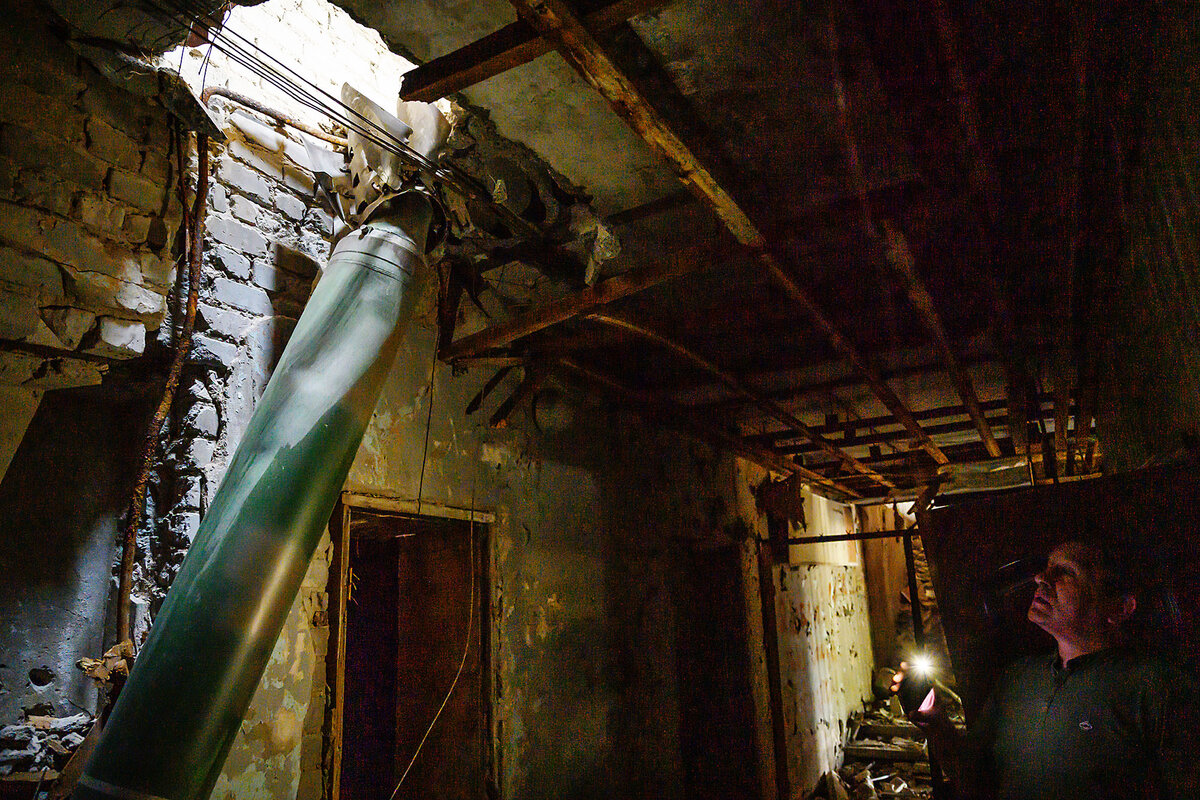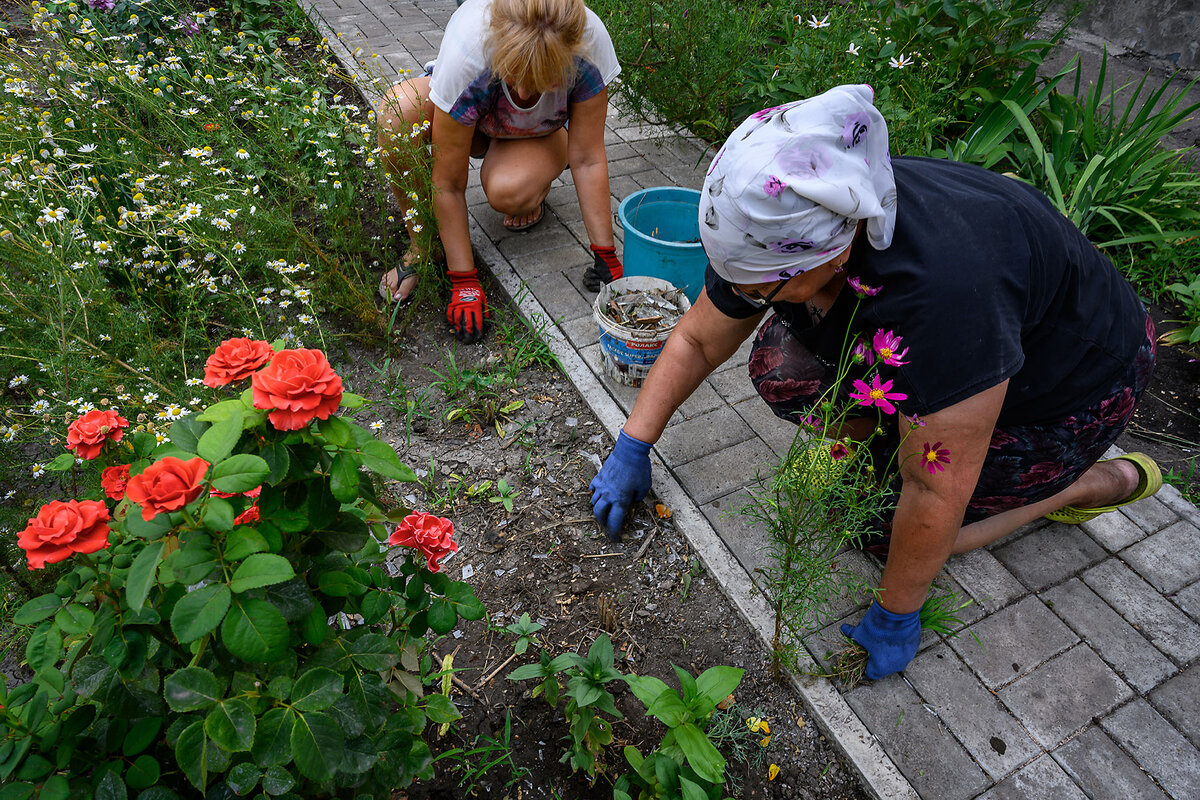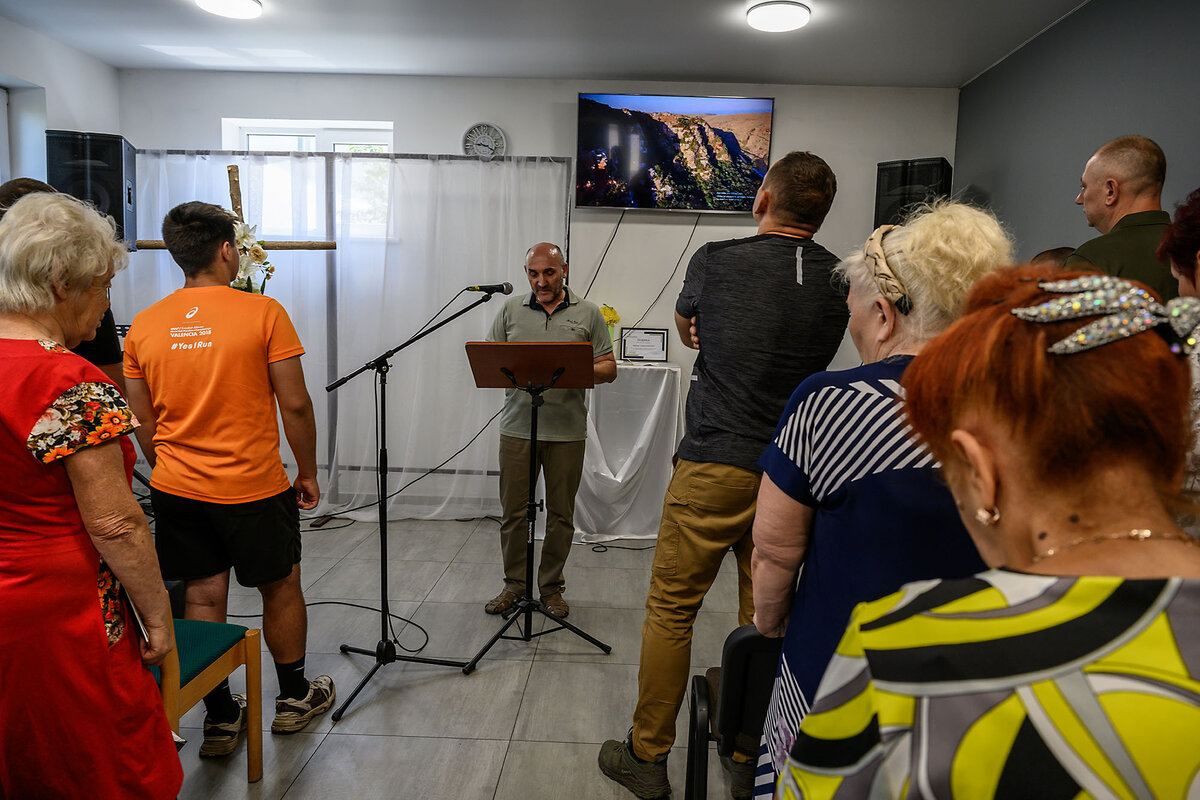In eastern Ukraine, Russian ‘glide bombs’ push civilians to flee
Loading...
| MYRNOHRAD, Ukraine
The tiny poodle strains at its leash and barks, triggering a deafening reaction from a pack of dogs roaming the wreckage in this town in Ukraine’s embattled far east, some 10 miles from Russia’s gradually advancing forces.
“A lot of people are leaving, and let their dogs go,” explains the poodle’s owner, a retired Ukrainian military pilot in a faded orange tank top, who gives the name Oleksandr.
On their right stands the shell of an apartment block, hollowed out just days before by a single Russian “glide bomb” – a heavy Soviet-era “dumb” bomb upgraded with wings and a guidance system, and launched from a plane deep inside Russian airspace.
Why We Wrote This
A story focused onThe residents of eastern Ukraine’s Donetsk region have been resilient in the face of the Russian war. But Russia’s introduction of upgraded, highly destructive “glide bombs” is changing civilians’ calculus.
On their left is all that remains of a kindergarten complex, newly built before Russia’s invasion of Ukraine in February 2022, but targeted a third time, also just days earlier.
“A lot of people lived here all their lives, and have apartments and jobs, but now our lives look like this,” says Oleksandr, as he describes how Russia’s advancing forces and use of glide bombs are triggering new departures from this Donetsk coal mining town.
He points to a nearby building entrance where a neighbor, Olena, “didn’t have a chance” when she stepped out after the first blast, only to be killed by a second – one of three deaths in the bombardment.
“Now the front is coming closer, and it’s more and more dangerous to live here,” says Oleksandr. “Now the intensity of the strikes is like never before.”
Augmenting Russia’s supply of rockets and missiles, the glide bombs, which can pack from 500 pounds to more than 3,000 pounds of explosive punch each, remain virtually unstoppable by Ukraine’s air defense systems.
Russia’s advance
To stay or to go is the decision being weighed by an increasing number of residents of Myrnohrad with heightened urgency in recent weeks.
Among the towns along Ukraine’s eastern front, Myrnohrad may be at particular risk, as it sits on an important Ukrainian supply line that Russian forces have already disrupted and – advancing west toward the Pokrovsk-Kostiantynivka road – appear determined to control.
“I tell everyone that you should leave, especially those with children and older people,” says Yurii Tretiak, Myrnohrad’s acting military administrator, who describes a state of “stable intensity.”
“We don’t know why they don’t like our kindergartens so much,” he says, noting that a number of schools have been targeted by 12 glide bombs, especially, that hit residential areas and claimed seven lives over a recent two-week period. Earlier in July, President Volodymyr Zelenskyy said Russia was launching 3,500 such glide bombs each month.
“We can see that people are actually dying, so [people] decided to leave,” says Mr. Tretiak. “We hope more weapons [for Ukrainian forces] will come soon, and the front-line situation will be better.”
He steps into an abandoned Soviet-era theater, where the engine of one Russian rocket still hangs from the ceiling where it fell, two weeks earlier. Ironically, on a wall nearby remains a tile mosaic that commemorates Moscow’s former friendship with the Ukrainian Soviet Socialist Republic.
“Of course, weapons can help stabilize the front. But we really hope they can fly 30 kilometers [behind Russian lines]. If used with sophistication, then this category of glide bomb won’t exist,” he says.
In late April, the United States approved a long-delayed $60.84 billion military and economic aid package, and European nations have also funneled billions of euros into weapons and ammunition for Ukraine.
But so far that has not stopped Russian forces from moving forward, if slowly. One recent 24-hour period reportedly saw 172 front-line clashes along this sector of the front alone.
“Hope dies last”
Days after one barrage, the residents of a decades-old building in Myrnohrad are still carefully collecting shards of glass from their rose garden. All the windows blew out when two Russian missiles struck an adjacent school and two more hit a bus stop, killing four coal mine workers.
Of 18 apartments, only six remain occupied – but the sense of community and family, the residents say, is robust.
“There is a saying, ‘Hope dies last,’” says a woman with a red blouse and gloves, who gives the name Iryna. “It goes day by day. Today we stay; maybe tomorrow we go.”
Svitlana, a laboratory worker at the mine who wears bright-red garden gloves to clear glass, says her family was only away for one month during the entire conflict, at the start of the war.
“But now, I am slowly packing my bags,” she says.
“The last two nights have been terrible,” adds Larysa Chirva, who wears a headscarf with flowers and has lived 60 of her 64 years in this building. She says her husband was thrown backward by the blast but not wounded.
“I will leave when there are no walls here,” she says.
Across town, Oleksandr Radin, a pastor at the Rock of Salvation evangelical church with grey stubble and a gold lower tooth, speaks after volunteering to put out a brush fire sparked by extreme temperatures.
“Since 2014, the Russians have said they would get Donetsk; it looks like they have moved into at-any-price mode,” he says. Mr. Radin was forced to leave the city of Avdiivka when it fell to Russia last February, and is active in evacuating civilians from contested areas.
Evacuation requests
The surge in Russian glide bomb and missile strikes has focused minds, he says. After receiving barely five evacuation requests during a recent three-month period, he received four from groups in the previous week alone.
“People are afraid to leave because they have no place to go after nearly three years of war,” says Mr. Radin. But past decisions to “stay until the [Russian] artillery can reach us” have been upended by the long reach of glide bombs.
Mr. Radin keeps a box of what he calls “souvenirs” given to him from the conflict, which now include the bent, super-lightweight wings of a Russian glide bomb.
“To say thank you, people used to bring shrapnel from missiles. Now they bring wings from glide bombs,” says Mr. Radin. “I tell people, ‘It’s time to turn your brain on and leave. It’s dangerous.’”
Among those heeding his call is Valentyna Mertsalova, a 70-something pensioner with white hair and a red dress, who the next day sat emotionally during a service at the pastor’s church. A handful of uniformed military soldiers in the 80-plus congregation were called forward and thanked for their service.
But Ms. Mertsalova was thinking about the deaths of her son and daughter-in-law, who were killed in their beds by a Russian missile in 2022 – and about the decision she and her husband have now taken to leave Myrnohrad for their safety.
That decision came two nights earlier, when their sleep was shattered by a barrage of 16 Russian glide bombs and missiles. In the morning she went outside, and was surprised that her neighbor planned to “wait it out.”
“What, girl?” she responded. “A few more nights like this, and we will be running [to flee] in front of the train!”
“I saw a crater made from a glide bomb, and no basement can save you,” says Ms. Mertsalova, whose eyes tear up at the thought of leaving.
“Everyone is scared. There are almost no young people,” she says. “Even if we are under the rubble, there will be no one to dig us out.”
Oleksandr Naselenko supported reporting for this story.






